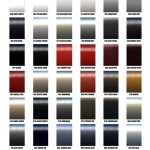Which Country Is Best For An Interior Design Course?
The field of interior design is a dynamic and evolving discipline, demanding a blend of artistic sensibility, technical proficiency, and cultural awareness. For aspiring interior designers, selecting the right country to pursue their education is a critical decision that can significantly impact their career trajectory. Several countries offer exceptional interior design programs, each with its unique strengths and specializations. This article will explore some of the leading contenders, focusing on key factors such as curriculum quality, industry connections, cultural influences, and career opportunities to aid prospective students in making an informed choice.
The "best" country for an interior design course is subjective and depends heavily on the individual student's goals, learning style, and financial resources. However, some nations consistently rank highly for their design education and offer a supportive environment for aspiring professionals. These countries often boast established design industries, renowned design schools, and a rich cultural heritage that can inspire and inform students' creative development. The subsequent sections will delve into specific countries and their respective offerings in interior design education.
Italy: A Cradle of Design and Innovation
Italy's influence on the world of design is undeniable. From furniture to fashion, Italian design is synonymous with elegance, innovation, and craftsmanship. Numerous prestigious design schools are located throughout Italy, particularly in Milan, Florence, and Rome. These institutions often emphasize a blend of traditional techniques and contemporary design principles, providing students with a comprehensive understanding of the field.
Italian interior design courses typically incorporate a strong focus on the history of art and architecture, providing students with a deep appreciation for the cultural context in which design evolves. Students also engage in practical studio work, developing their skills in space planning, material selection, and furniture design. Furthermore, many Italian design schools maintain close ties with leading Italian furniture manufacturers and design firms, offering students valuable internship and networking opportunities.
The cost of living and tuition fees in Italy can vary depending on the city and the school. While Milan tends to be more expensive than other Italian cities, it also offers a greater concentration of design-related opportunities. Scholarships and financial aid options are available for international students, but competition can be fierce. Learning Italian, even basic conversational skills, enhances the learning experience and improves opportunities for professional engagement.
Graduates of Italian interior design programs often find employment in a variety of sectors, including residential design, commercial design, hospitality design, and furniture design. The global reputation of Italian design also opens doors to international career opportunities.
The United Kingdom: A Hub for Creative Industries
The United Kingdom boasts a thriving creative sector, with London serving as a global center for design, fashion, and the arts. Numerous universities and design schools in the UK offer highly regarded interior design programs, known for their rigorous academic standards and emphasis on practical application. London, in particular, provides access to numerous design firms, museums, and galleries, enriching the learning experience.
Interior design courses in the UK often emphasize critical thinking and problem-solving skills, encouraging students to develop innovative and sustainable design solutions. The curriculum typically covers a wide range of topics, including space planning, lighting design, materials and finishes, and building regulations. Students also gain practical experience through studio projects, site visits, and internships.
British design education often incorporates a strong focus on research and theory, encouraging students to critically examine the social, cultural, and environmental contexts of design. This approach fosters a deeper understanding of the role of design in shaping the built environment. Many universities offer specialized programs in areas such as sustainable design, healthcare design, and retail design, catering to specific career interests.
The cost of studying in the UK can be significant, particularly in London. However, numerous scholarships and funding opportunities are available for international students. A strong command of English is essential for success in UK interior design programs. Graduates of UK programs are well-prepared for careers in a variety of sectors, including residential design, commercial design, retail design, and exhibition design.
The United States: Diverse Opportunities and Specializations
The United States offers a vast and diverse landscape for interior design education, with numerous universities and art schools across the country offering a wide range of programs. The US interior design industry is highly competitive, with opportunities in a variety of sectors, including residential design, commercial design, hospitality design, healthcare design, and retail design. Major cities like New York, Los Angeles, and Chicago are hubs for design activity, offering numerous career opportunities and access to leading design firms.
Interior design programs in the US often emphasize a blend of artistic creativity and technical skills. The curriculum typically covers a wide range of topics, including space planning, lighting design, materials and finishes, building codes, and computer-aided design (CAD). Many programs also incorporate a focus on sustainable design practices, reflecting the growing importance of environmental considerations in the design industry.
US design schools often offer specialized programs in areas such as kitchen and bath design, sustainable design, universal design, and hospitality design. This allows students to tailor their education to specific career interests. Internship opportunities are often plentiful in the US, providing students with valuable real-world experience and the chance to network with industry professionals.
The cost of tuition and living expenses in the US can vary widely depending on the location and the institution. Scholarships and financial aid options are available for international students, but competition can be intense. A strong academic record and a portfolio of design work are typically required for admission to competitive US interior design programs. Graduates of US programs are well-prepared for careers in a variety of sectors, both in the US and internationally.
Denmark: Pioneering Sustainable and Functional Design
Denmark is globally recognized for its pioneering contributions to modern design, particularly in furniture and interiors. Danish design principles emphasize functionality, simplicity, and sustainability, creating spaces that are both aesthetically pleasing and practical. Danish interior design education often reflects these values, emphasizing a human-centered approach to design that considers the needs and well-being of the users.
Danish design schools typically offer a hands-on, studio-based learning environment where students develop their skills through practical projects and collaborations. The curriculum often incorporates a strong focus on materials and craftsmanship, encouraging students to experiment with different techniques and develop their own unique design aesthetic. Sustainability is a key consideration in Danish design education, with students encouraged to explore environmentally friendly materials and design strategies.
Danish design education also emphasizes the importance of collaboration and teamwork. Students often work on group projects, simulating the collaborative environment of a professional design studio. This approach fosters communication skills and the ability to work effectively with others. Many Danish design schools maintain close ties with local design firms and manufacturers, providing students with opportunities for internships and networking.
While the cost of living in Denmark can be relatively high, tuition fees for international students are often lower than in other Western countries. Furthermore, a number of scholarships and funding opportunities are available. A strong command of English is typically required for admission to Danish design programs, as many courses are taught in English. Graduates of Danish design programs are well-prepared for careers in a variety of sectors, including residential design, commercial design, furniture design, and product design.
Japan: Harmony, Minimalism, and Innovation
Japan offers a unique perspective on interior design, rooted in its rich cultural heritage and traditions. Japanese design emphasizes harmony, balance, and a connection to nature. Minimalism is a key principle, creating spaces that are uncluttered and serene. Japanese interior design education often reflects these values, emphasizing a holistic approach to design that considers the relationship between humans and their environment.
Japanese design schools offer a range of programs in interior design, architecture, and related fields. The curriculum typically covers a wide range of topics, including space planning, lighting design, materials and finishes, and traditional Japanese design principles. Students also gain practical experience through studio projects, site visits, and internships. Japanese design education often emphasizes the importance of craftsmanship and attention to detail.
Japanese design is also known for its innovative use of technology. Japanese design schools often incorporate the latest digital tools and techniques into their curriculum, preparing students for the demands of the modern design industry. Sustainability is also a growing concern in Japanese design, with students encouraged to explore environmentally friendly materials and design strategies.
The cost of living and tuition fees in Japan can vary depending on the city and the school. Scholarships and financial aid options are available for international students, but competition can be fierce. Learning Japanese is essential for success in Japanese interior design programs, as most courses are taught in Japanese. Graduates of Japanese design programs are well-prepared for careers in a variety of sectors, including residential design, commercial design, hospitality design, and exhibition design, both in Japan and internationally.

Top 10 Interior Design Schools Around The World Arch2o Com

Interior Design Courses Abroad In Fee College Scholarship Idc

Top 10 Interior Design Schools Around The World Arch2o Com

Top 10 Interior Design Schools Around The World Arch2o Com

Top 10 Interior Design Schools Around The World Arch2o Com

Top 10 Interior Design Schools Around The World Arch2o Com

Top 10 Interior Design Schools Around The World Arch2o Com

Top 10 Countries To Study Architecture Maven Consulting Services

Best Interior Design Schools In The U S For 2024

Neoclassical Interior Design Neoclassic Home Decorating Style
Related Posts








